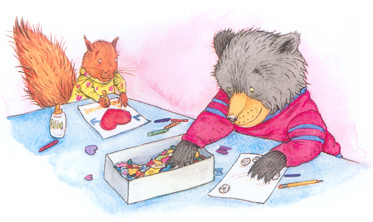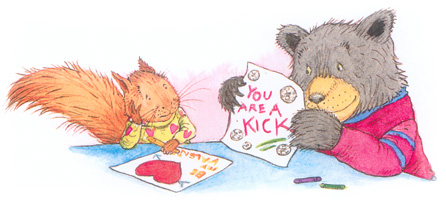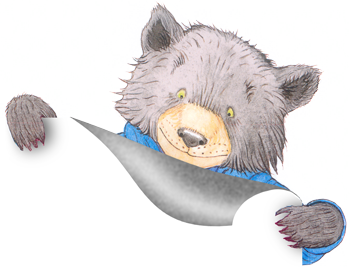
[ Back to Picture Books ] -> [ Back to A String of Hearts ]
Author's Note About Making Valentines
A String of Hearts
I believe I am a far better writer because I am a mother. This is particularly true with my picture books which I began writing as bedtime stories for my children to help them think through playground conundrums. A String of Hearts celebrates Valentine's Day and school parties, but it is also about popularity—children recognizing who their true friends are. It also highlights the joys of actually making a card that is tailored specifically to the recipient. I spent many happy hours with my daughter and son at the kitchen table piled high with doilies, stickers, markers, and construction paper. (I think I am a closet kindergarten teacher!) It took time and creative energy, but making those cards prompted such wonderful discussions about the nature of affection and what my children really relished about each individual friend.

Depending on how old your child is or how comfortable she is with scissors, you may need to do some pre-cutting of cards and hearts. For hearts, fold the paper in half, draw a teardrop along the fold and cut (Mary Ann shows you how on page 12). Or simply trace around a heart cookie cutter. You’ll definitely want to pre-separate the doilies which can stubbornly stick together. Remember that doilies are lacy and have holes in them! So have newspaper or paper towels underneath them to catch the extra glue when you apply glitter or other decorations To avoid those middle-of-the-project panics when things don’t look quite right, help your child pre-plan and arrange items on the card before he actually begins to glue things down. A series of tiers is fun: a card (paper folded in half like a book cover) topped with a round doily, stacked with a big heart, a small doily or cut-out, and then a smaller heart. Maybe stick a Hershey’s kiss in the center or stickers. (Do try to let you child create on his/her own, without your directing too much. Your respecting and praising his efforts will go a long way in building self-esteem and making the process a happy and fun one for both of you.) If your child is too young to sign a card, maybe trace around her hand or have her plant a kiss on the card (applying lipstick will be an added bit of fun for some!).

Check out these links for more ideas:
- http://crafts.kaboose.com/paper-conversation-heart-wreath.html
- http://crafts.kaboose.com/cupid-heart-card.html
- http://crafts.kaboose.com/valentines-day-doily-heart-card.html
- http://crafts.kaboose.com/thumbprint-heart-card.html
- http://holidays.kaboose.com/valentines-day-cards.html
- http://crafts.kaboose.com/valentine_homemade.html
- http://familyfun.go.com/valentines-day/valentines-day-cards/

You can learn to make valentines by reading A String of Hearts, (just follow along with Sam as Mary Ann shows him how) but here are some basic tips: First, bring patience and a sense of humor to the table. Making a mess is half the fun!
